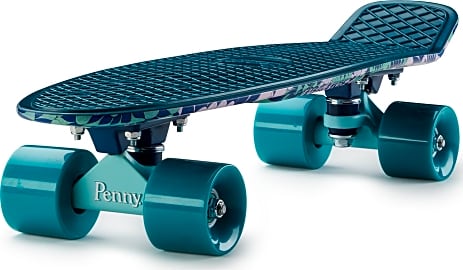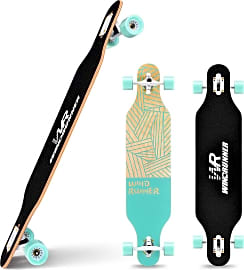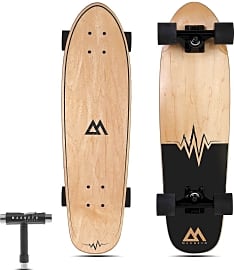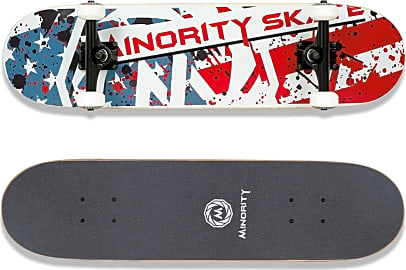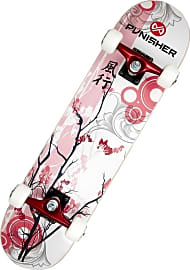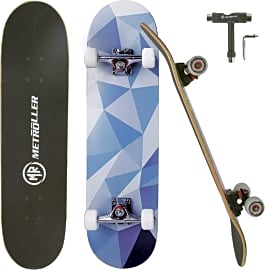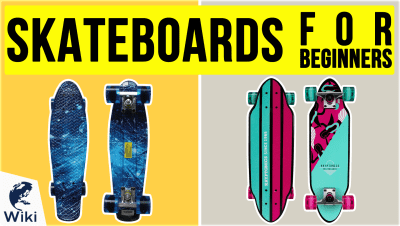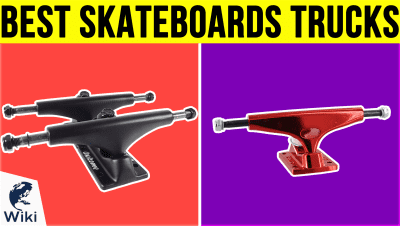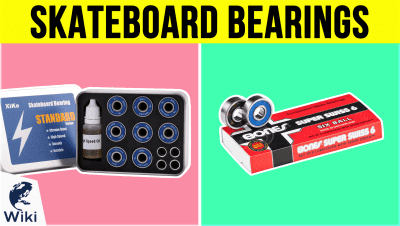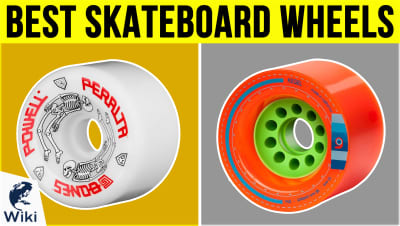The 10 Best Skateboards

This wiki has been updated 39 times since it was first published in October of 2015. Whether you are an amateur or a seasoned pro, you'll find a skateboard among our selection that will soon have you doing acid drops and wheel slides, or simply commuting to and from work or school. No matter what you use yours for, it's a fun way to get plenty of exercise, but be sure to avoid injury by wearing protective gear, staying far away from traffic, and remaining on smooth, dry surfaces. When users buy our independently chosen editorial selections, we may earn commissions to help fund the Wiki.
Editor's Notes
April 12, 2021:
While they are certainly basic in principle, skateboards can be customized to suit a range of skating styles and can be upgraded to include special hardware and graphics, so in this review, we chose a selection that performs well straight out of the box. With a focus on the intermediate to professional-level skater, our ranking should have something to offer everyone who is serious about skateboards.
In this latest update, we included the Metroller Complete, which is an affordable choice that performs well as an all-rounder for both tricks and cruising, once it's been broken in. This has been highly rated by adults returning to skating after a hiatus, as well as younger generations that have a little experience but don't wish to invest too much money initially.
On the more professional end of the spectrum lies the CCS Complete. Created by a company with decades of experience in board manufacture, this model is priced accordingly. While it performs very well indeed, it's aesthetically quite plain and doesn't make much of a statement by itself, so buyers may wish to add their own customization.
For those who are looking to perform tricks, the Magneto Mini has a beautifully crafted deck with a gently tapering profile and a natural wood tone. Its double kicktails make it a versatile choice that can pull off all sorts of moves at the skate park. In contrast, we selected the Windrunner Freeride longboard, which is built for cruising. While it's not cheap, it features excellent trucks, bearings, and wheels, and has an overall build quality that places it firmly on our list of the best.
January 07, 2020:
The Penny Cruiser Althea joins our selection today to replace the Penny Graphic Complete. This compact, 22-inch choice fits nicely into a locker, which makes it great for use in commuting to school or work. No grip tape is required, thanks to its non-slip, waffle-top surface. Its decorated underside features a tri-tone psychedelic floral pattern. It’s built to last, with a durable powder-coated finish, yet it’s still backed by a lifetime warranty.
The Retrospec Zed Longboard also comes on board in this update. It sports a cool, vintage look inspired by mid-20th century California surfboards. This is reflected in its aqua and black pipeline stripe designs, as well as its “Sunset,” “Green Flora,” and “White Mable” designs. It’s made from sustainably sourced bamboo and 8-ply Canadian maple. It replaces the Boss Board, the bearings of which many feel just aren’t up to par.
For safety’s sake, be sure to wear protective gear, including a helmet, whenever you’re on your skateboard. In addition, stay in areas that are far away from vehicle traffic, and avoid areas where the ground is slippery and wet. Homemade ramps are a bad idea, as is skateboarding too quickly or trying risky stunts. Skateboarding is not safe for kids under the age of 10, who do not have fully developed motor coordination. Children who are skateboarding should always be supervised by an adult to ensure their safety. Before using a new skateboard for the first time, make sure the wheels are properly tightened, to avoid potential injuries.
If you’re a newbie and are looking for more models for someone just getting their feet wet, check out our list of the best skateboards for beginners.
Special Honors
Zumiez Build Your Custom Skateboard In no time, you can create your own fun compilation that matches your personality perfectly, and Zumiez will send it to you, fully assembled and ready to ride. Choose your deck from among dozens of fun and snarky styles, trucks and wheels that are both durable and colorful, as well as bearings, hardware, and grip tape. zumiez.com
CCS Custom Skateboard Deck From a 30-year-old manufacturer of skateboards, and related clothing and accessories, comes the ability to design a 7-ply maple deck that’s uniquely yours. You can upload your own image or use the text tool provided. After that, you’ll choose from a selection of wheels, bearings, grip tape, and trucks. Once you're finished with your creation, it will be shipped to you, fully assembled. ccs.com
Hjalte Halberg - Dragon Gate Created by artist Emile Laurent, this colorful deck comes with eclectic artwork, and is stained in vibrant colors such as red or yellow. It’s made in Mexico and comes with grip tape, with dimensions that include a 32-inch length, an 8.375-inch width, a 7-inch nose, a 6.625-inch tail, and a 14.5-inch wheel base. Wheels, trucks, and all other components are sold separately. polarskateco.com
From Boredom To Boarding: A Revolution Of Simplicity On Wheels
The deck is the actual surface piece of the board on which a rider stands to perform tricks or control their degree of motion.
If you love the outdoors, traveling in style, and prefer to have as much control over your mode of transportation as possible, a skateboard is just what you need. Not just for high school kids or sports celebrities like Tony Hawk, the skateboard can be a useful and fun tool that can take you wherever you need to go, while also being a great outlet for the release of energy.
A skateboard is a special type of sports equipment crafted from a long piece of maple wood with a polyurethane coating for increased durability and easy sliding while in motion. The wood is attached to four wheels and propelled forward by either the push of a rider's foot or by the gravitational forces acting upon them in a given circumstance, which means that a rider can simply stand on the board's surface and ride it downhill without using their feet at all. Skateboards are available as either long boards or short boards. Long boards are usually between thirty-five and sixty inches long and are ideal for cruising purposes and downhill racing. They are typically more expensive than short boards, which are around thirty inches long and are designed for getting air and performing stunts or tricks.
Regardless of the length of these boards, they each have several components in common that include a deck, grip tape, trucks, and wheels. The deck is the actual surface piece of the board on which a rider stands to perform tricks or control their degree of motion. Decks range between seven and ten inches in width and although seven-ply wood is the most common material for them, they can also be crafted out of bamboo, carbon fiber, and even plastic. Decks are shaped in several unique concave designs, which include radial, progressive, W-concave, tub, and asymmetric. Radial concave decks have U-shaped curves and are ideal for beginners, as they provide one's feet with a reliable grip.
Progressive designs deliver a more dramatic upward curve and a wider base, providing increasingly secure footing and a locked-in feel. The W-concave shape is more narrow with an additional center curve, allowing for a greater shift in energy between the heel and toe. This design also boasts more responsive control and quick turning capabilities. Tub concave decks resemble the radial shape, however their rails extend at a sharp angle instead of a gradual curve. Asymmetrical decks feature rails that extend at different angles, affording more power to a rider's heels when making turns. Less commonly used are decks with convex and completely flat shapes. Convex boards offer an upwards-arching shape, which some downhill skateboarders prefer for a more natural feel, whereas flat designs increase available foot space and are more popular for experienced riders looking to perform fancy tricks.
Staying Informed And Safe
While the skateboard has a lot of moving parts, one's safety, comfort, and ease to learn new skills and perform tricks are all of equal importance. For this reason, choosing the right type of deck and wheels should be two of the first considerations, as the board's shape, material construction, and wheel makeup will all have a significant impact on your ability to control the equipment and maintain good aerodynamics. Additionally, the width of the deck is important, so one must take their height, shoe size, and style of riding into account in order to ensure the deck offers as much support as possible, regardless of application.
While the skateboard has a lot of moving parts, one's safety, comfort, and ease to learn new skills and perform tricks are all of equal importance.
Secondly, consider the types of environments in which you'll be using the board. If you plan to ride in both dry and wet settings, just keep in mind that you may need to consider the possibility of replacing the deck more often, as certain woods have a tendency to show wear over time when exposed to extreme temperatures.
If you're a beginner and you want to get a feel for what riding is like, then a long board can be a great first choice, as it's designed for cruising instead of performing advanced stunts. That being said, use of a long board can evolve into the eventual purchase of a short board when one becomes more comfortable with the nuances of riding.
Finally, consider the type of grip tape you'll want on the board. While function is important in this regard to give your feet ample support, there's nothing wrong with adding some bling to the board's surface either. Many skateboard retailers will offer you several choices of grip tape and board styles, so it's definitely important to ask a lot of questions.
Grip tape adds additional assurance for a rider's feet. It is made from a sheet of colored paper or fabric with adhesive on one side and a fine, sand paper surface on the other. Applied to the top surface of a skateboard, grip tape gives a person's feet an improved grip while maintaining stability for performing tricks. Skateboard trucks connect both the wheels and ball bearings to the deck and are directly attached to the deck themselves. They are usually constructed from aluminum alloy. The wheels are mounted to their axles via steel bearings. The wheels are made from polyurethane and available in a range of different shapes and sizes to suit most any skill level.
A Brief History Of Skateboards
Originally referred to as sidewalk surfing, the birth of skateboarding dates back to the early 1940s and the use of wooden boxes with roller skates attached to their bottoms. While the board itself cannot necessarily be attributed to a single inventor of the time and was, instead, a spontaneous invention from multiple sources, the modern style of many of today's skateboards took form during the 1950s when California surfers were looking for a physical activity to keep them busy during times when the waves were flat. The first manufactured skateboards were ordered by a Los Angeles surf shop and were designed to be used by surf enthusiasts during their downtime. At the time, the shop owner set up an arrangement with the Chicago Roller Skate Company to produce sets of skate wheels, which the shop would then attach to square wooden boards.
The first manufactured skateboards were ordered by a Los Angeles surf shop and were designed to be used by surf enthusiasts during their downtime.
By the 1960s, additional manufacturers of surfing equipment entered the scene and began to create skateboards made to resemble small surf boards. One of the first skateboard exhibitions was sponsored by Larry Stevenson in 1963 (developer of the kicktail) and held at the Pier Avenue Junior High School in Hermosa Beach, California.
The 1970s saw the birth of the first polyurethane wheels for manufactured skateboards, sparking a rise in their popularity due to the improved traction they offered to riders. Along with this came the ability to craft wider board decks up to ten inches in width, further improving a rider's control.
The first two skate parks to be opened appeared in March of 1976 (Skateboard City in Florida and Carlsbad Skatepark in San Diego, California). With the evolution of improved handling, skateboarders also began to experiment with vertical tricks along the walls of empty swimming pools during the California drought of the 1970s.
By 2006 over 2,400 skate parks existed worldwide, many of which were designed by skaters themselves for the purpose of appealing to all skill levels. Many of these parks are still just as popular today.


